Study on the Effects of Cryogenic Treatment on WC-Co Cemented Carbide at Different Scales Using an Indentation Technique
Abstract
1. Introduction
2. Materials and Methods
2.1. Materials
2.2. Deep Cryogenic Treatment
2.3. Microstructure Investigation
2.4. Nanoindentation Testing
2.5. Microindentation Testing
3. Results and Discussion
3.1. Microstructure Analysis
3.2. Indentation Test Result
3.2.1. Nanoindentation Result
3.2.2. Microindentation Test Results
4. Conclusions
Author Contributions
Funding
Data Availability Statement
Acknowledgments
Conflicts of Interest
References
- Katiyar, P.K.; Singh, P.; Singh, R.; Kumar, A. Modes of failure of cemented tungsten carbide tool bits (WC/Co): A study of wear parts. Int. J. Refract. Met. Hard Mater. 2016, 54, 27–38. [Google Scholar] [CrossRef]
- Tang, J.Y.; Luo, L.M.; Liu, Z.; Zan, X.; Wu, Y.C. Shape Retention of Cemented Carbide Prepared by Co Melt Infiltration into Un-Sintered WC Green Parts Made via BJ3DP. Int. J. Refract. Met. Hard Mater. 2022, 107, 105904. [Google Scholar] [CrossRef]
- Yildiz, A.B.; Babu, R.P.; Bonvalet-Rolland, M.; Busch, S.; Ryukhtin, V.; Weidow, J.; Norgren, S.; Hedström, P. Quantification of Nano-Scale Interface Structures to Guide Mechanistic Modelling of WC Grain Coarsening Inhibition in V-Doped Hard Metals. Mater. Des. 2021, 207, 109825. [Google Scholar] [CrossRef]
- Stein, S.; Heberle, J.; Gürtler, F.J.; Cvecek, K.; Roth, S.; Schmidt, M. Influences of Nozzle Material on Laser Droplet Brazing Joints with Cu89Sn11 Preforms. Phys. Procedia 2014, 56, 709–719. [Google Scholar] [CrossRef][Green Version]
- Huang, X.; Jiang, F.; Wang, Z.; Wu, X.; Huang, S.; Liu, Y.; Zhang, J.; Shi, X. A Review on the Balancing Design of Micro Drills. Int. J. Adv. Manuf. Technol. 2023, 126, 4849–4871. [Google Scholar] [CrossRef] [PubMed]
- Yang, Y.; Zhang, C.; Wang, D.; Zhang, H. Additive Manufacturing of WC-Co Hardmetals: A Review. Int. J. Adv. Manuf. Technol. 2020, 108, 1653–1673. [Google Scholar] [CrossRef]
- Sarin, V.K. Cemented carbide cutting tools. In Advances in Powder Technology; Chin, D.Y., Ed.; ASM: Almere, The Netherlands, 1981; pp. 253–287. [Google Scholar]
- Oksa, M.; Turunen, E.; Suhonen, T.; Varis, T.; Hannula, S.-P. Optimization and characterization of high velocity oxy-fuel sprayed coatings: Techniques, materials, and application. Coatings 2011, 1, 17–52. [Google Scholar] [CrossRef]
- Vilhena, L.; Domingues, B.; Fernandes, C.; Senos, A.; Ramalho, A. Mechanical and tribological characterization of WC-Co and WC-AISI 304 composites by a newly developed equipment. Materials 2022, 15, 1187. [Google Scholar] [CrossRef] [PubMed]
- García, J.; Ciprés, V.C.; Blomqvist, A.; Kaplan, B. Cemented carbide microstructures: A review. Int. J. Refract. Met. Hard Mater. 2019, 80, 40–68. [Google Scholar] [CrossRef]
- Schwanekamp, T.; Marginean, G.; Reuber, M.; Ostendorf, A. Impact of Cobalt Content and Grain Growth Inhibitors in Laser-Based Powder Bed Fusion of WC-Co. Int. J. Refract. Met. Hard Mater. 2022, 105, 105814. [Google Scholar] [CrossRef]
- Ma, R.; Ju, S.; Chen, H.; Shu, C. Effect of cobalt content on microstructures and wear resistance of tungsten carbide–cobalt-cemented carbides fabricated by spark plasma sintering. IOP Conf. Ser. Mater. Sci. Eng. 2017, 207, 012019. [Google Scholar] [CrossRef]
- Saketi, S.; Odelros, S.; Östby, J.; Olsson, M. Experimental study of wear mechanisms of cemented carbide in the turning of Ti6Al4V. Materials 2019, 12, 2822. [Google Scholar] [CrossRef]
- Olsson, M.; Lenrick, F.; M’Saoubi, R.; Larsson, H.; Markström, A.; Petrusha, I.; Ståhl, J.E.; Bushlya, V. Study of wear mechanisms of cemented carbide tools during machining of single phase niobium. Wear 2020, 458–459, 203244. [Google Scholar] [CrossRef]
- Katiyar, P.K.; Maurya, R.; Singh, P.K. Failure Behavior of Cemented Tungsten Carbide Materials: A Case Study of Mining Drill Bits. J. Mater. Eng. Perform. 2021, 30, 6090–6106. [Google Scholar] [CrossRef]
- Scussel, H.J. Friction and wear of cemented carbides. In ASM Handbook; ASM International: Materials Park, OH, USA, 1992; Volume 18, p. 796.S. [Google Scholar]
- Shipway, P.H.; Hogg, J.J. Dependence of microscale abrasion mechanisms of WC-Co hardmetals on abrasive type. Wear 2005, 259, 44–51. [Google Scholar] [CrossRef]
- Doeg, H.H. Cemented hard metals: Their basis with particular reference to the tungsten carbide-cobalt system. J. S. Afr. Inst. Min. Metall. 1960, 60, 663. [Google Scholar]
- Pirso, J.; Letunovitš, S.; Viljus, M. Friction and wear behaviour of cemented carbides. Wear 2004, 257, 257–265. [Google Scholar] [CrossRef]
- Larsen-Basse, J. Binder extrusion in sliding wear of WC-Co alloys. Wear 1985, 105, 247–256. [Google Scholar] [CrossRef]
- Pereira, P.; Vilhena, L.; Sacramento, J.; Senos, A.; Malheiros, L.; Ramalho, A. Influence of Different Binders and Severe Environmental Conditions on the Tribological and Electrochemical Behaviour of WC-Based Composites. Lubricants 2022, 10, 145. [Google Scholar] [CrossRef]
- Sandoval, D.A.; Rinaldi, A.; Tarragó, J.M.; Roa, J.J.; Fair, J.; Llanes, L. Scale effect in mechanical characterization of WC-Co composites. Int. J. Refract. Met. Hard Mater. 2018, 72, 157–162. [Google Scholar] [CrossRef]
- Beste, U.; Jacobson, S. A new view of the deterioration and wear of WC/Co cemented carbide rock drill buttons. Wear 2008, 264, 1129–1141. [Google Scholar] [CrossRef]
- Duszová, A.; Halgaš, R.; Bľanda, M.; Hvizdoš, P.; Lofaj, F.; Dusza, J.; Morgiel, J. Nanoindentation of WC–Co hardmetals. J. Eur. Ceram. Soc. 2013, 33, 2227–2232. [Google Scholar] [CrossRef]
- Bonache, V.; Rayón, E.; Salvador, M.D.; Busquets, D. Nanoindentation study of WC–12Co hardmetals obtained from nanocrystalline powders: Evaluation of hardness and modulus on individual phases. Mater. Sci. Eng. A 2010, 527, 2935–2941. [Google Scholar] [CrossRef]
- Arunkarthikeyan, K.; Balamurugan, K.; Rao, P.M.V. Studies on cryogenically treated WC-Co insert at different soaking conditions. Mater. Manuf. Process. 2020, 35, 545–555. [Google Scholar] [CrossRef]
- Gill, S.S.; Singh, J.; Singh, H.; Singh, R. Metallurgical and mechanical characteristics of cryogenically treated tungsten carbide (WC–Co). Int. J. Adv. Manuf. Technol. 2011, 58, 119–131. [Google Scholar] [CrossRef]
- Zhang, W.; Tian, J.; Wu, X.; Zheng, Y.; Yuan, J.; Zheng, M. Wear Characteristics and Micro-Cutting Damage Model of Cemented Carbide by Deep Cryogenic Treatment. J. Mater. Res. Technol. 2024, 32, 2279–2295. [Google Scholar] [CrossRef]
- Chinnasamy, M.; Rathanasamy, R.; Palaniappan, S.K.; Pal, S.K.; Muthuswamy, P.; Korrayi, R.R.; Uddin, M.E. Microstructural and Tribological Characterization of Cryogenic Treated WC-Co Cutting Bits under Different Holding Times for Rock Cutting Applications. J. Mater. Eng. Perform. 2024, 33, 4933–4950. [Google Scholar] [CrossRef]
- Thakur, D.; Ramamoorthy, B.; Vijayaraghavan, L. Influence of different post treatments on tungsten carbide-cobalt inserts. Mater. Lett. 2008, 62, 4403–4406. [Google Scholar] [CrossRef]
- Padmakumar, M.; Guruprasath, J.; Achuthan, P.; Dinakaran, D. Investigation of phase structure of cobalt and its effect in WC–Co cemented carbides before and after deep cryogenic treatment. Int. J. Refract. Met. Hard Mater. 2018, 74, 87–92. [Google Scholar] [CrossRef]
- Formisano, A.; Capece Minutolo, F.; Caraviello, A.; Carrino, L.; Durante, M.; Langella, A. Influence of eta-phase on wear behavior of WC-Co carbides. Adv. Tribol. 2016, 2016, 5063274. [Google Scholar] [CrossRef]
- Průcha, V.; Jansa, Z.; Veselý, V. Influence of deep cryogenic processing on carbide grain size in sintered carbide WC-Co. Manuf. Technol. 2021, 21, 32–37. [Google Scholar] [CrossRef]
- Kim, J.; Suh, Y.J.; Kang, I. First-principles calculations of the phase stability and the elastic and mechanical properties of η-phases in the WC–Co system. J. Alloys Compd. 2016, 656, 213–217. [Google Scholar] [CrossRef]
- Zhang, W.; Wu, X.; Tian, J.; Huang, X.; Yu, W.; Zhu, W.; He, J. Improving wear resistance and corrosive resistance of cemented carbide for mud pulser rotor by deep cryogenic treatment. Materials 2024, 17, 1195. [Google Scholar] [CrossRef]
- Chen, Y.; Zhang, L.; Zhong, Z.; Wang, S. Effect of substrates characteristics on tribological behaviors of AlTiN-based coated WC–Co cemented carbides. Coatings 2022, 12, 1517. [Google Scholar] [CrossRef]
- ASTM E92-17; Standard Test Methods for Vickers Hardness and Knoop Hardness of Metallic Materials. ASTM International: West Conshohocken, PA, USA, 2017.
- Pero, R.; Maizza, G.; Montanari, R.; Ohmura, T. Nano-Indentation Properties of Tungsten Carbide-Cobalt Composites as a Function of Tungsten Carbide Crystal Orientation. Materials 2020, 13, 2137. [Google Scholar] [CrossRef]
- Bľanda, M.; Duszová, A.N.; Csanádi, T.; Dusza, J. Indentation fatigue of WC grains in WC–Co composite. J. Eur. Ceram. Soc. 2014, 34, 3365–3370. [Google Scholar] [CrossRef]
- Shen, Z.; Su, Y.; Liang, Z.; Long, X. Review of Indentation Size Effect in Crystalline Materials: Progress, Challenges, and Opportunities. J. Mater. Res. Technol. 2024, 31, 117–132. [Google Scholar] [CrossRef]
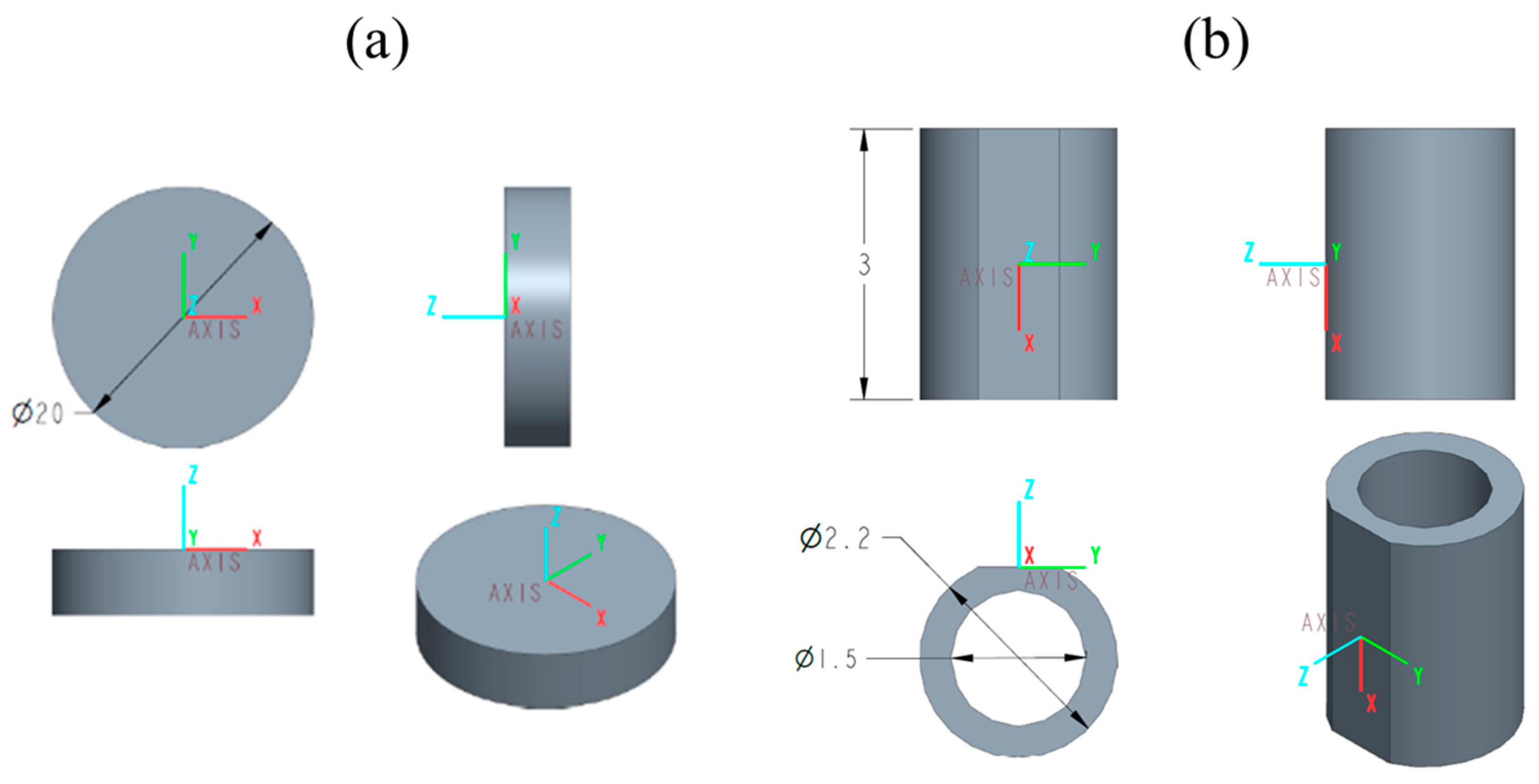
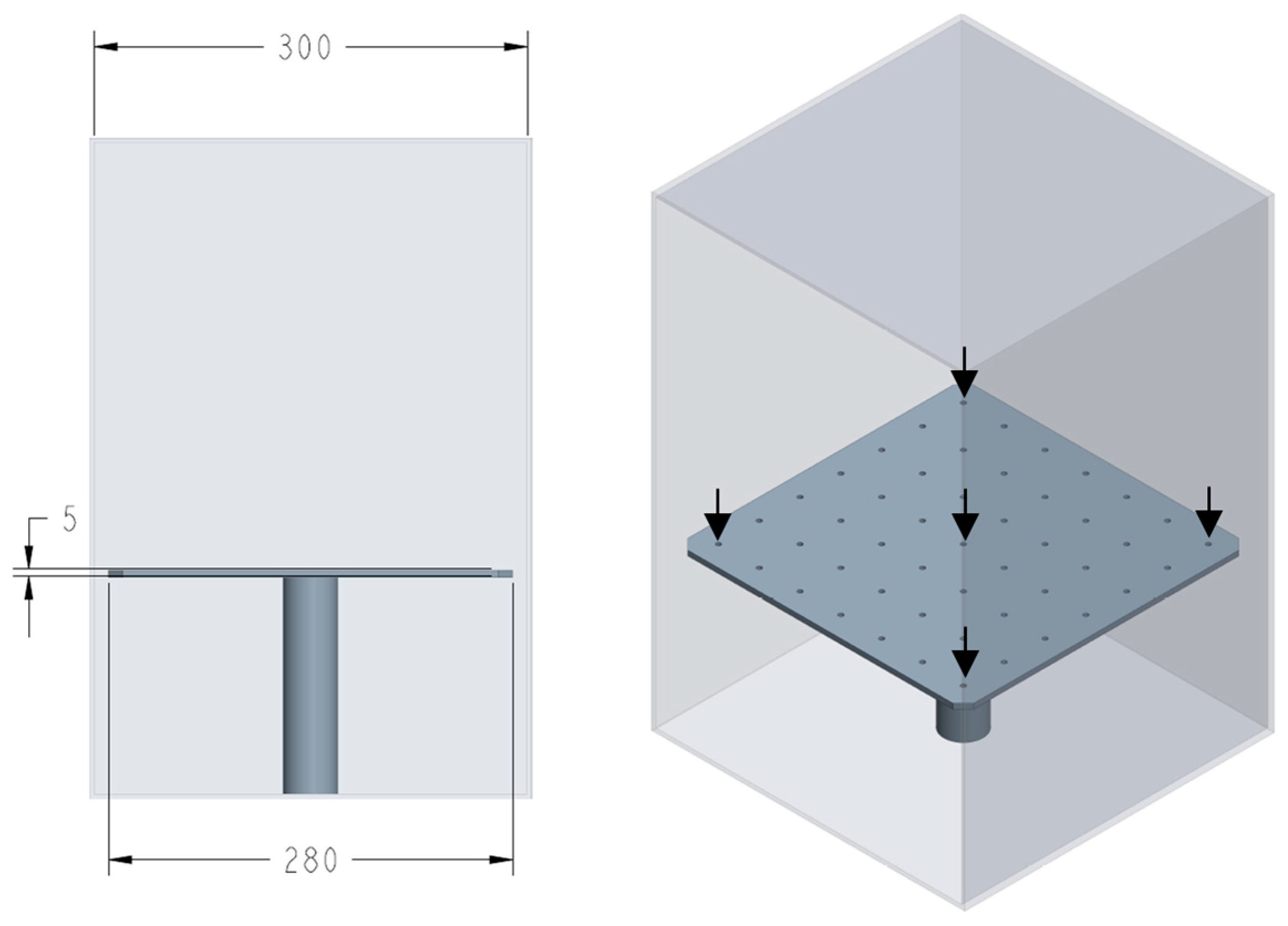

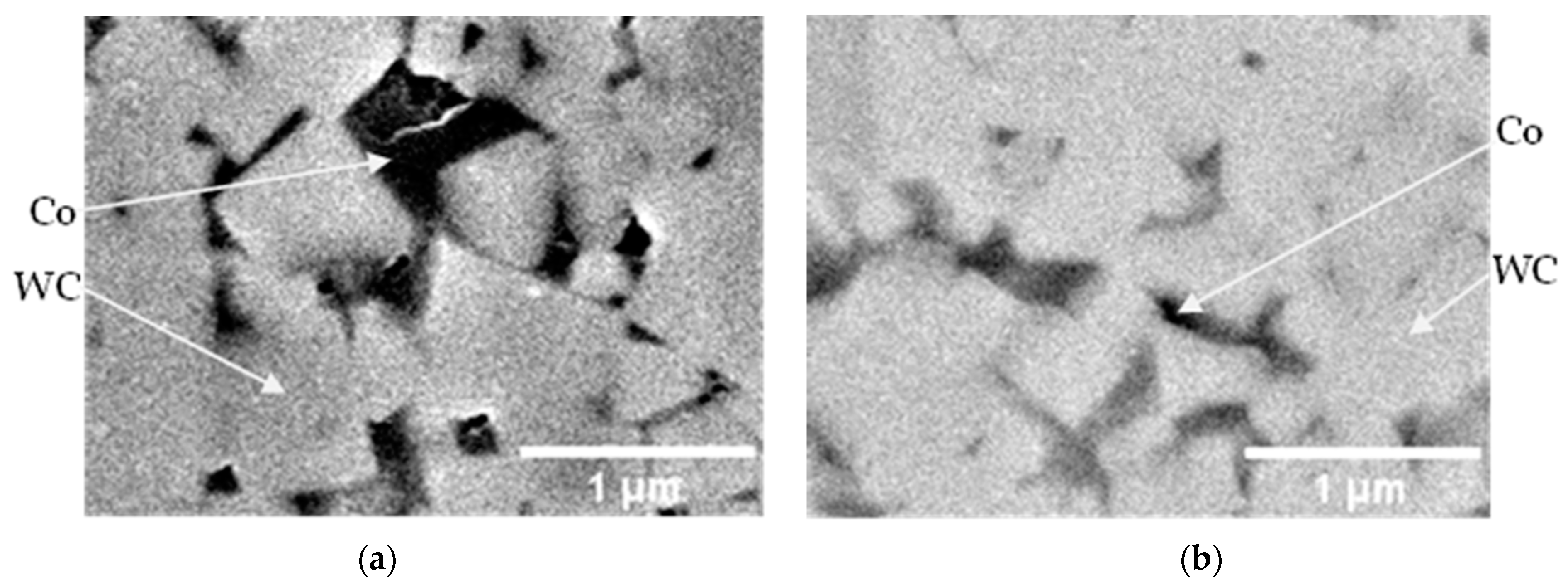
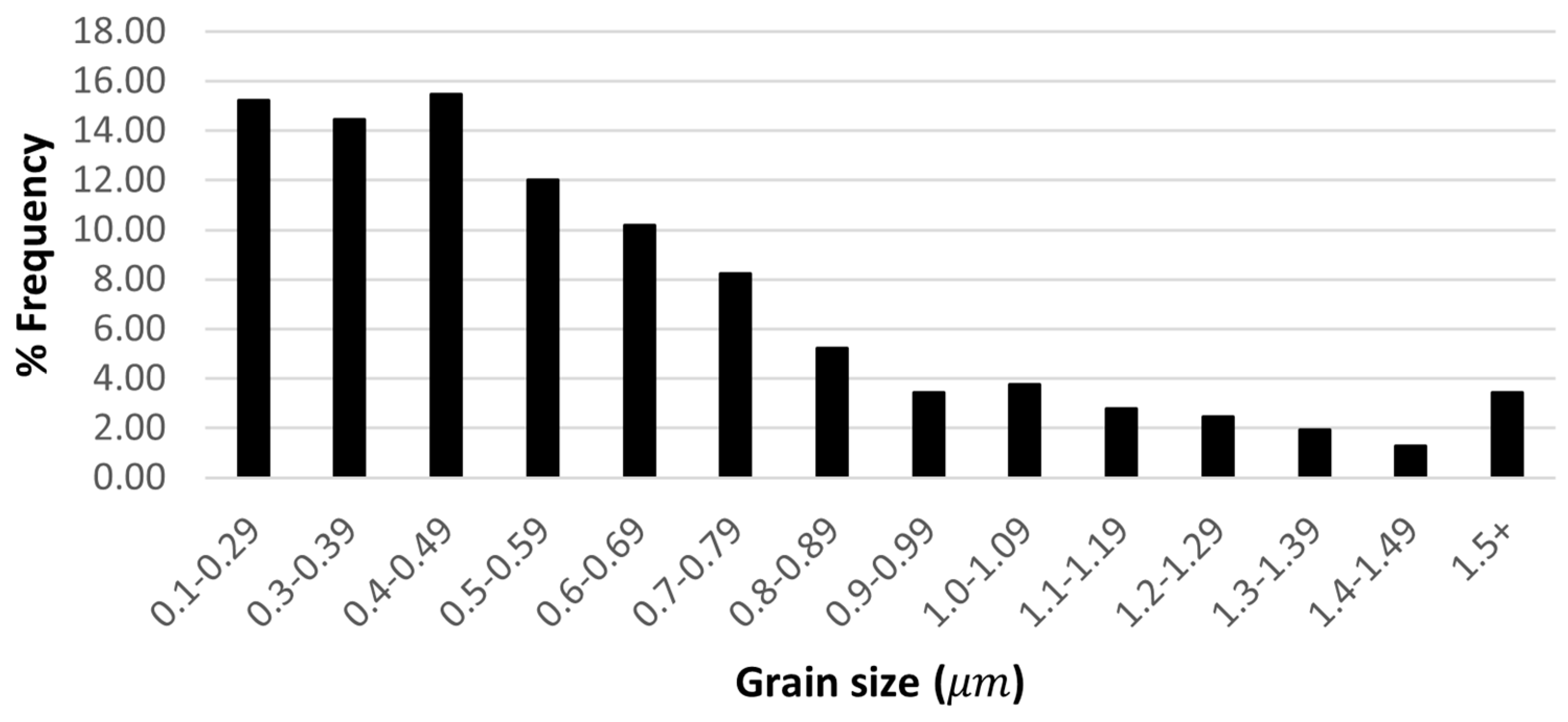

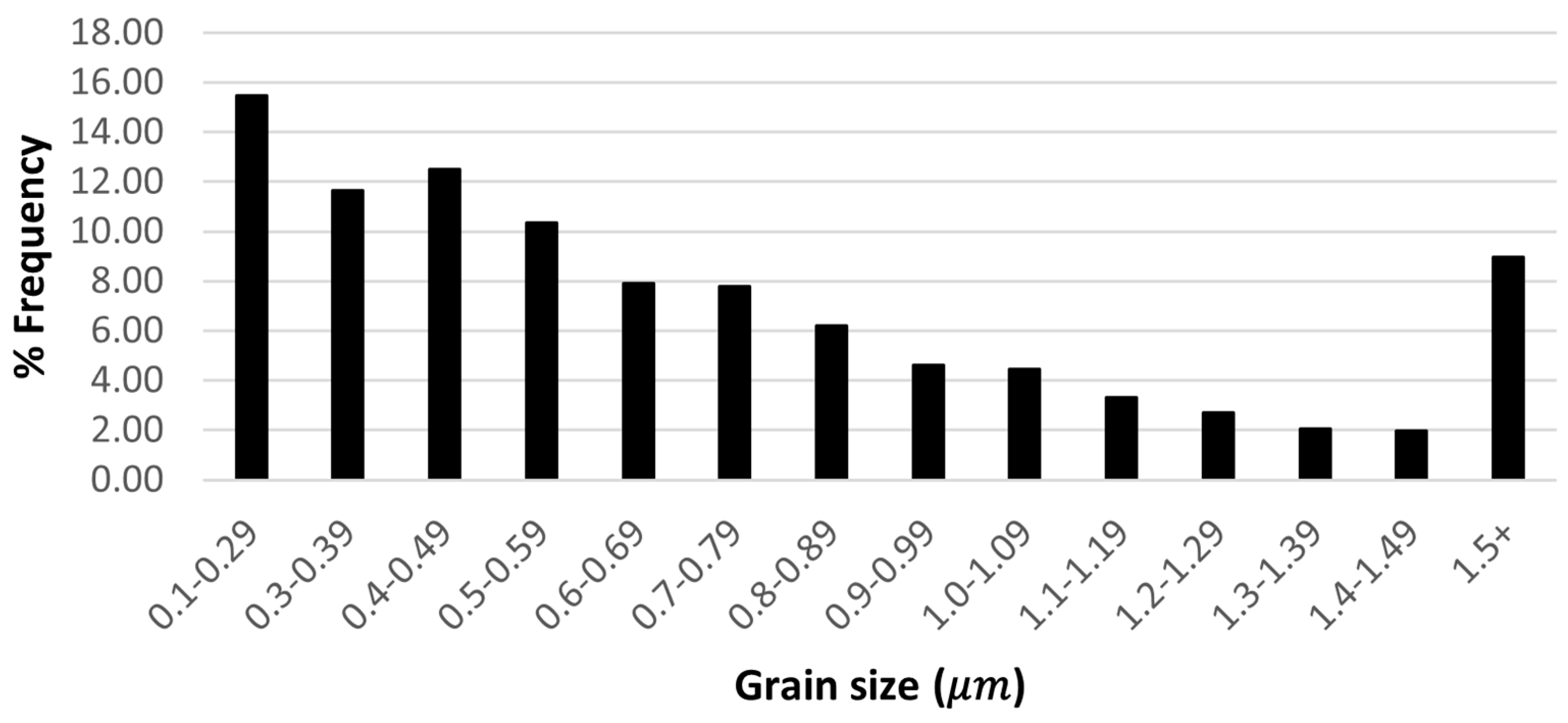
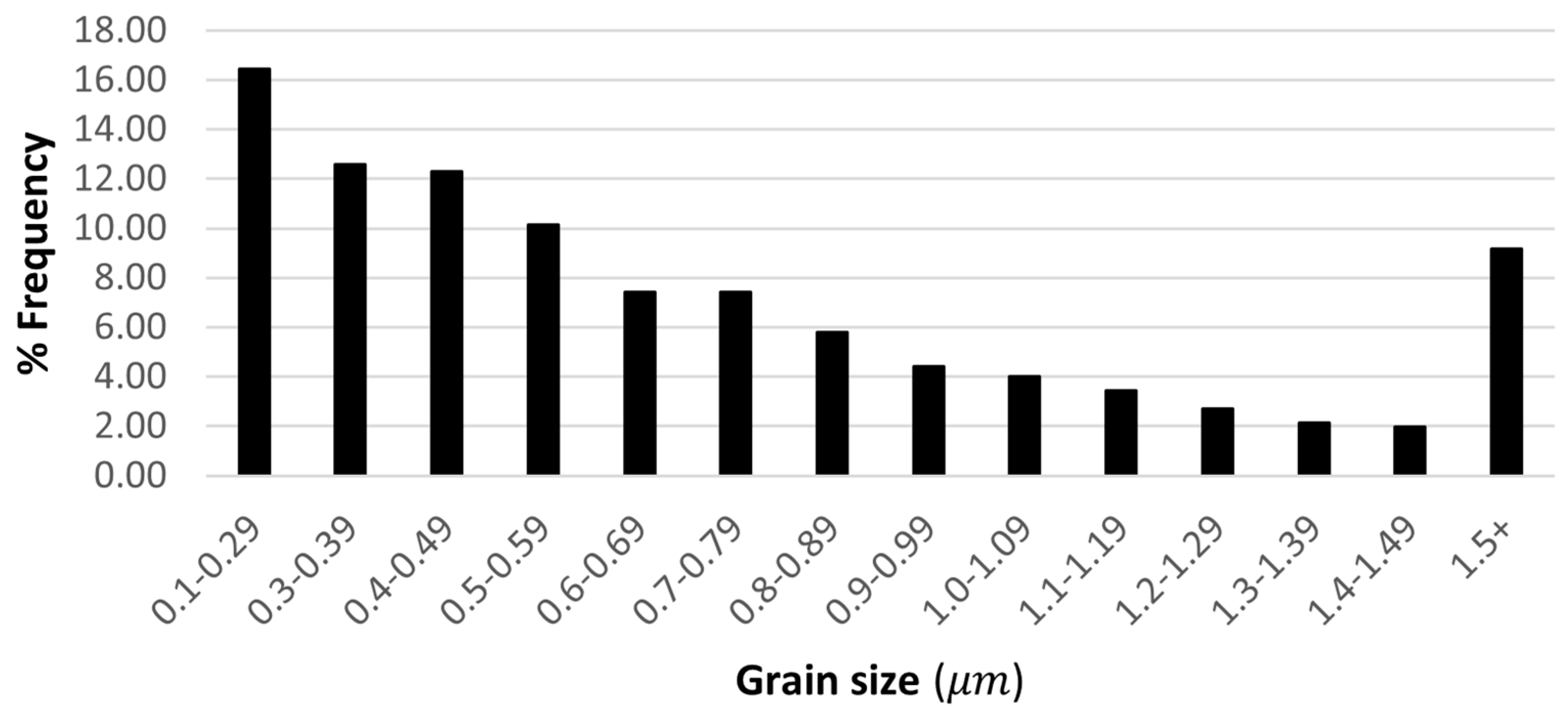
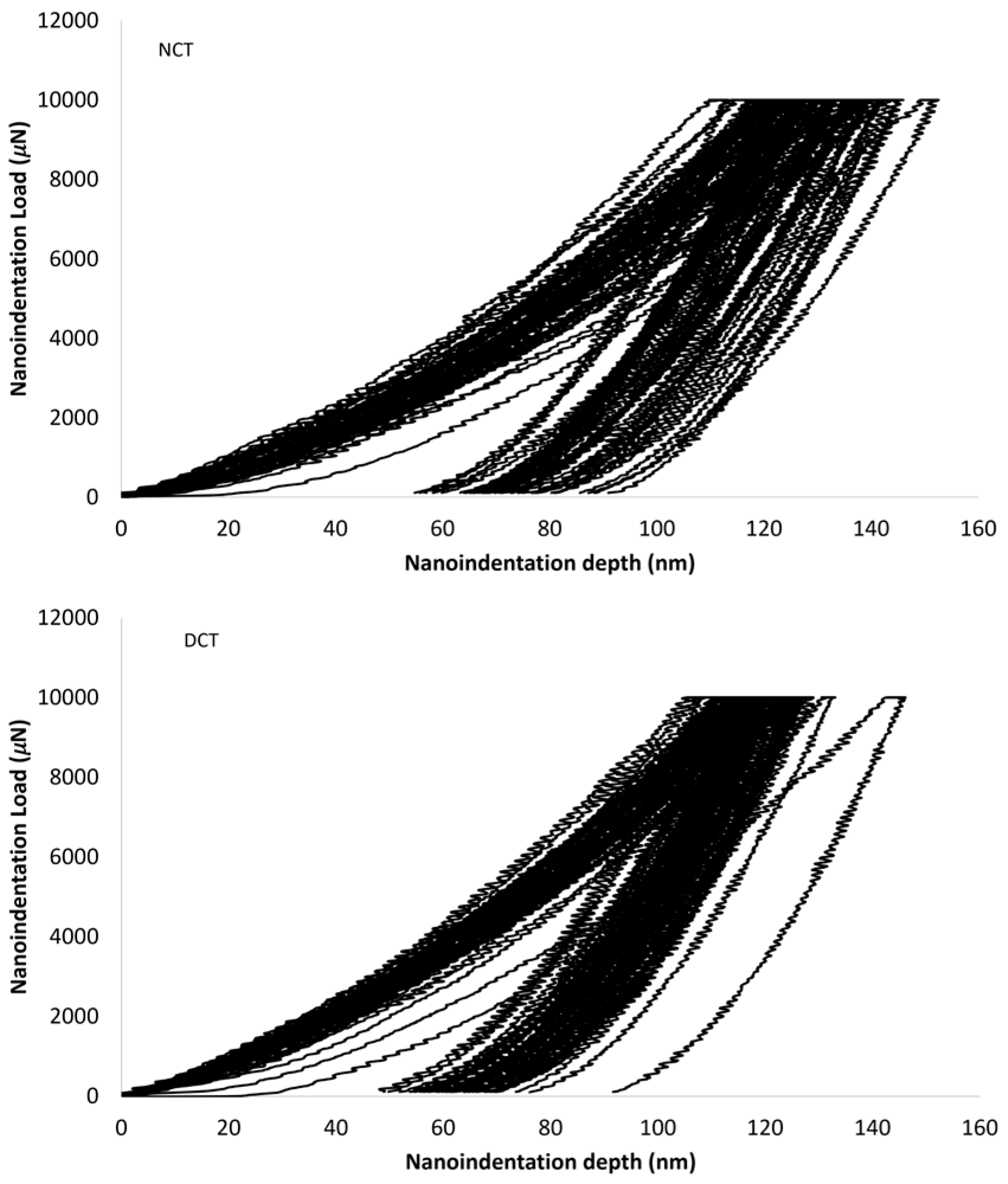
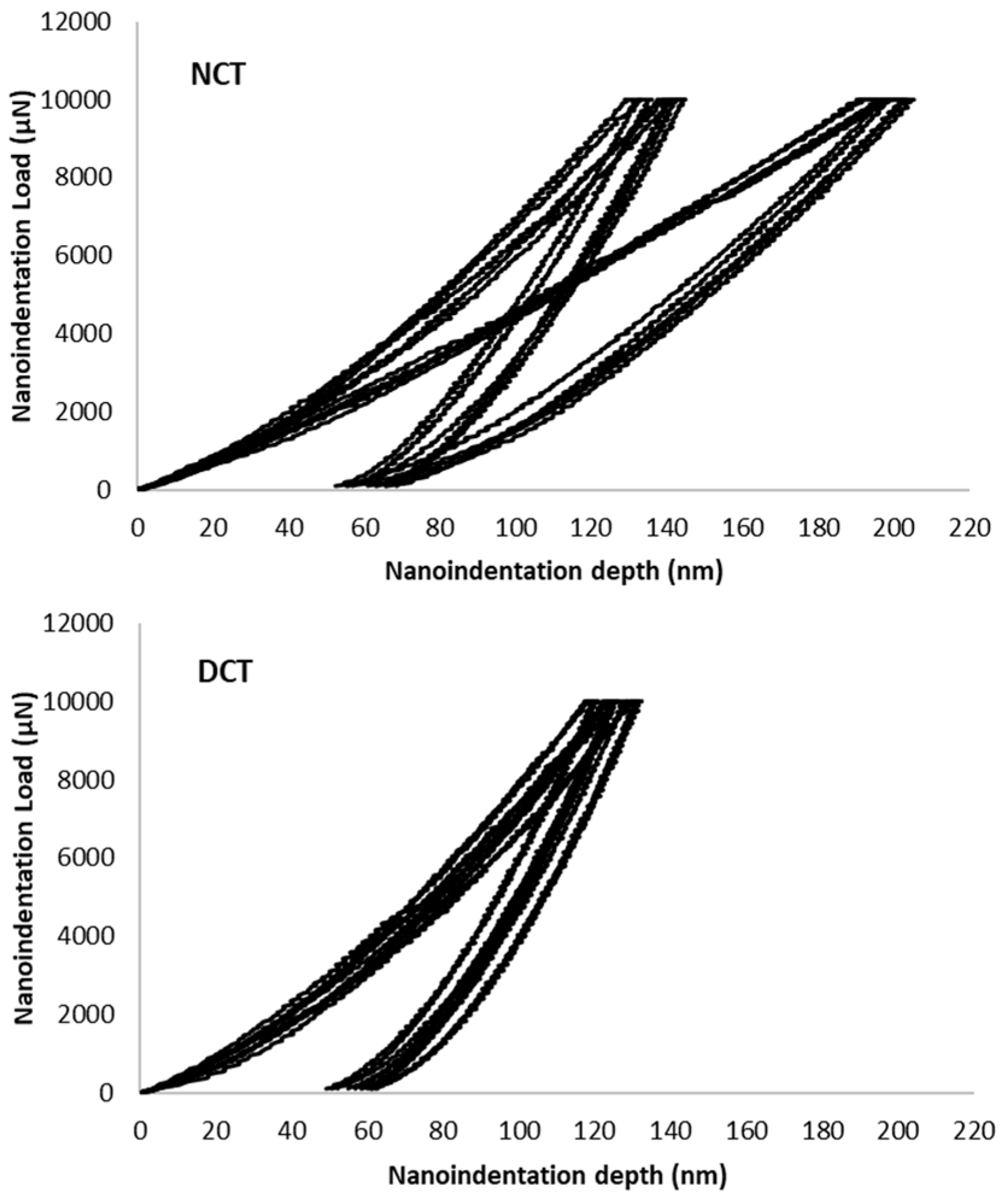
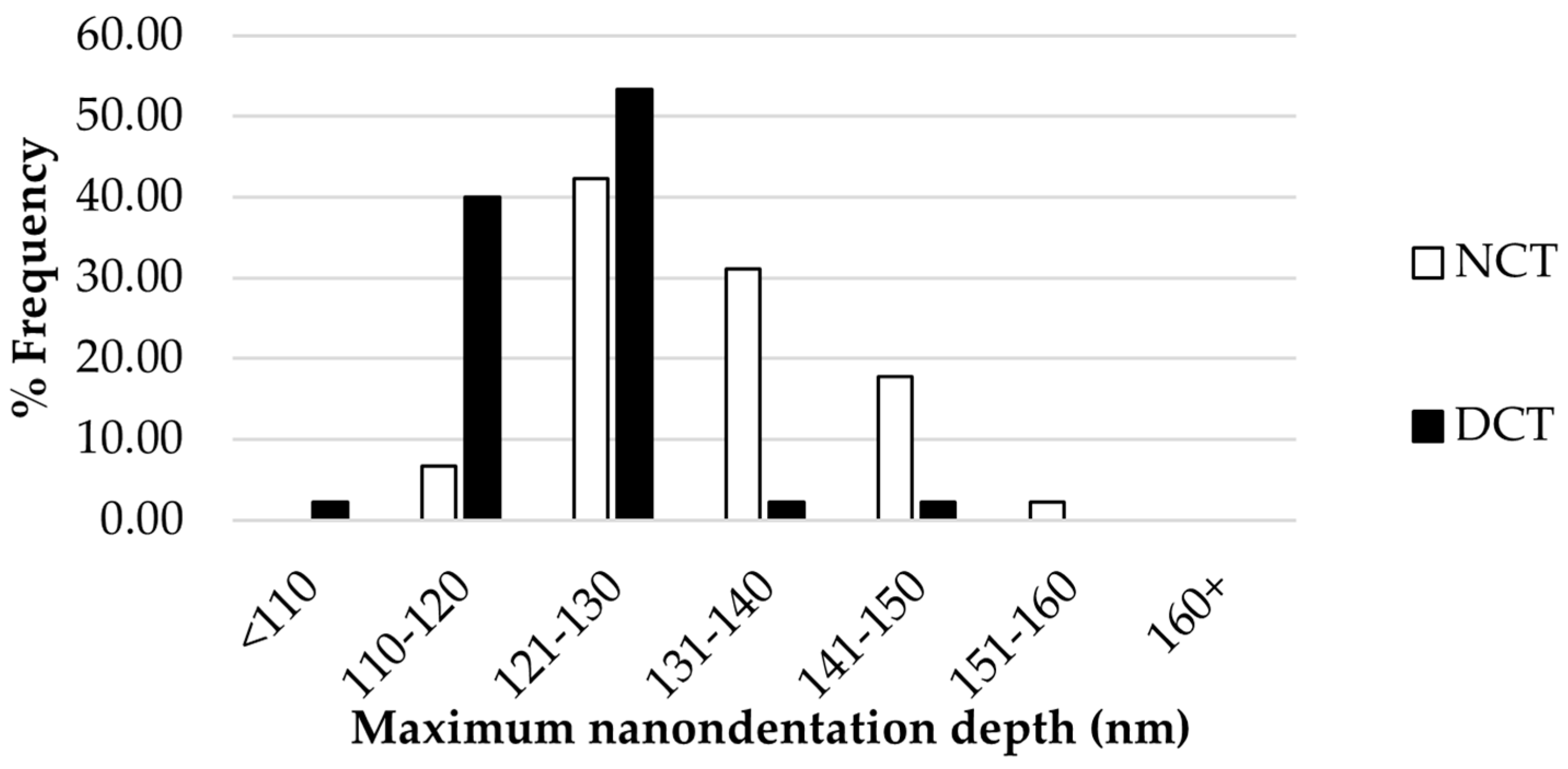
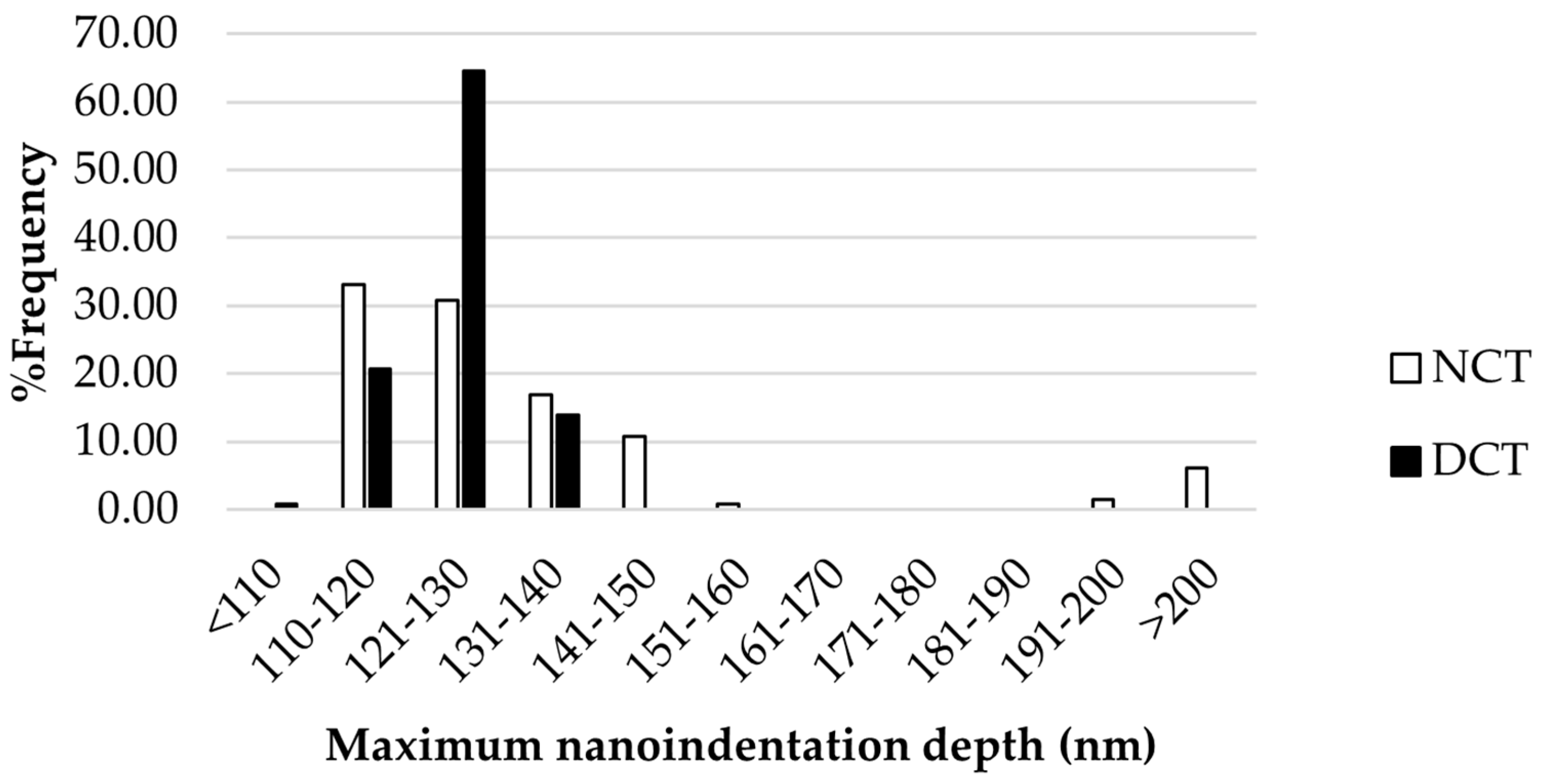
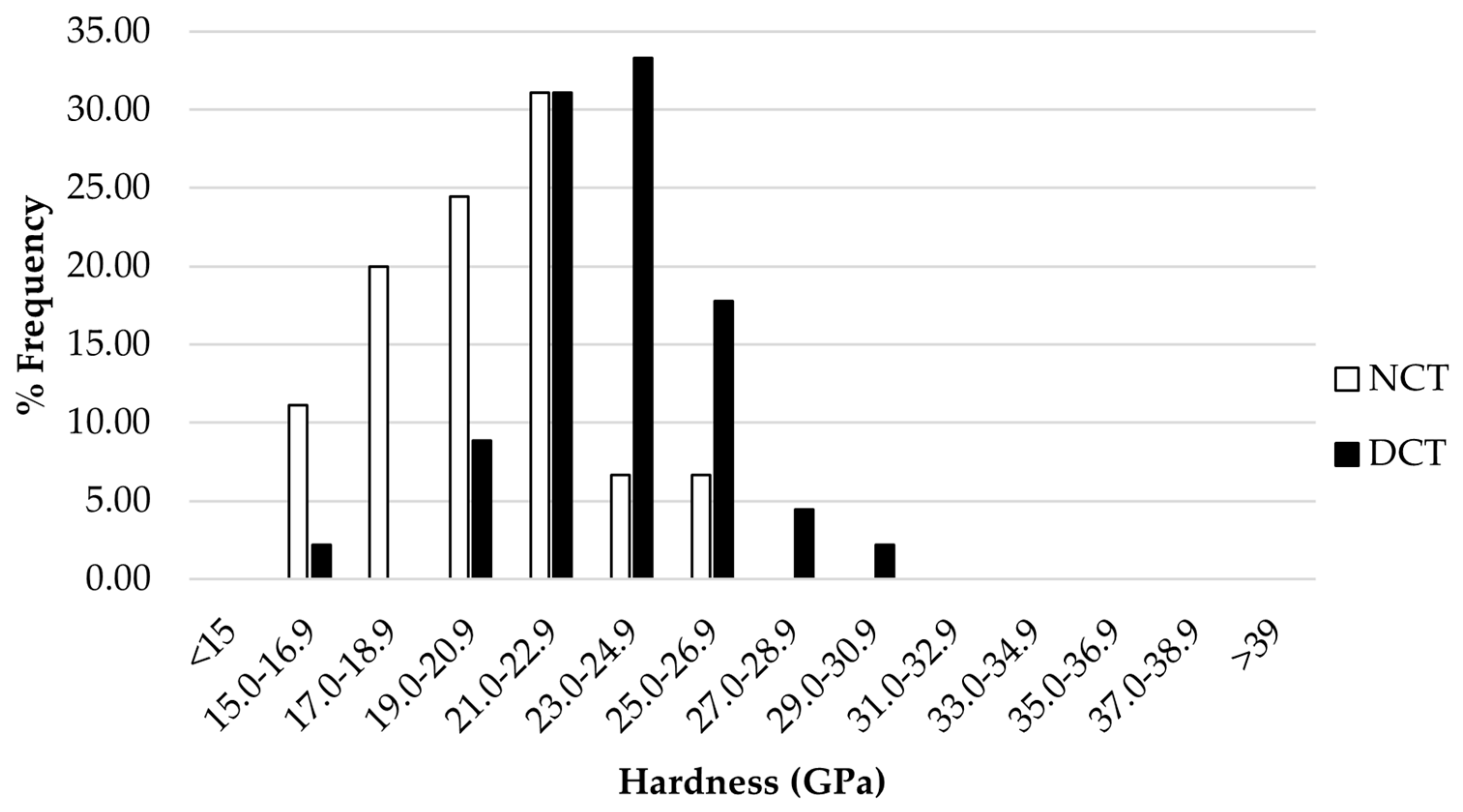
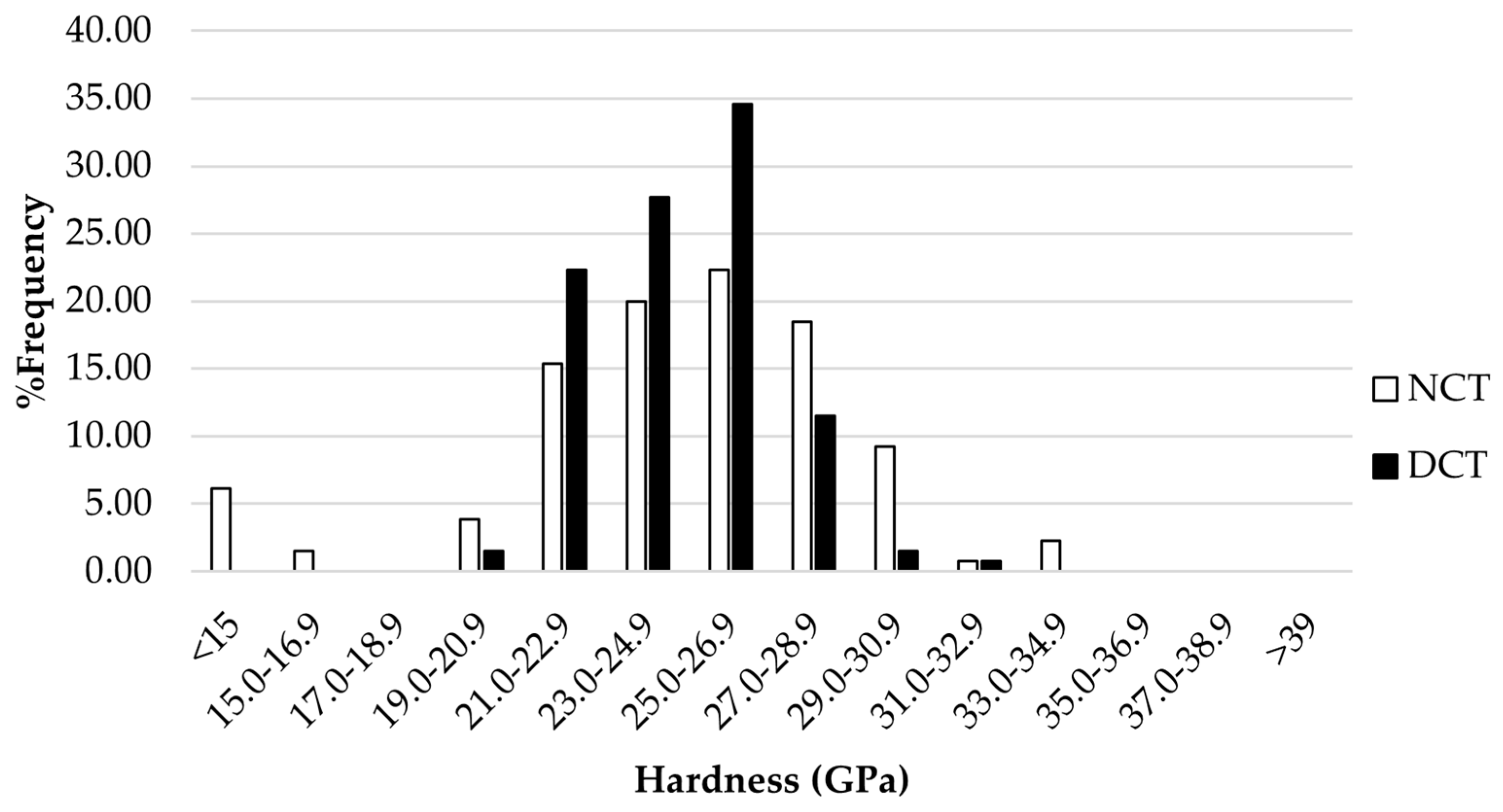
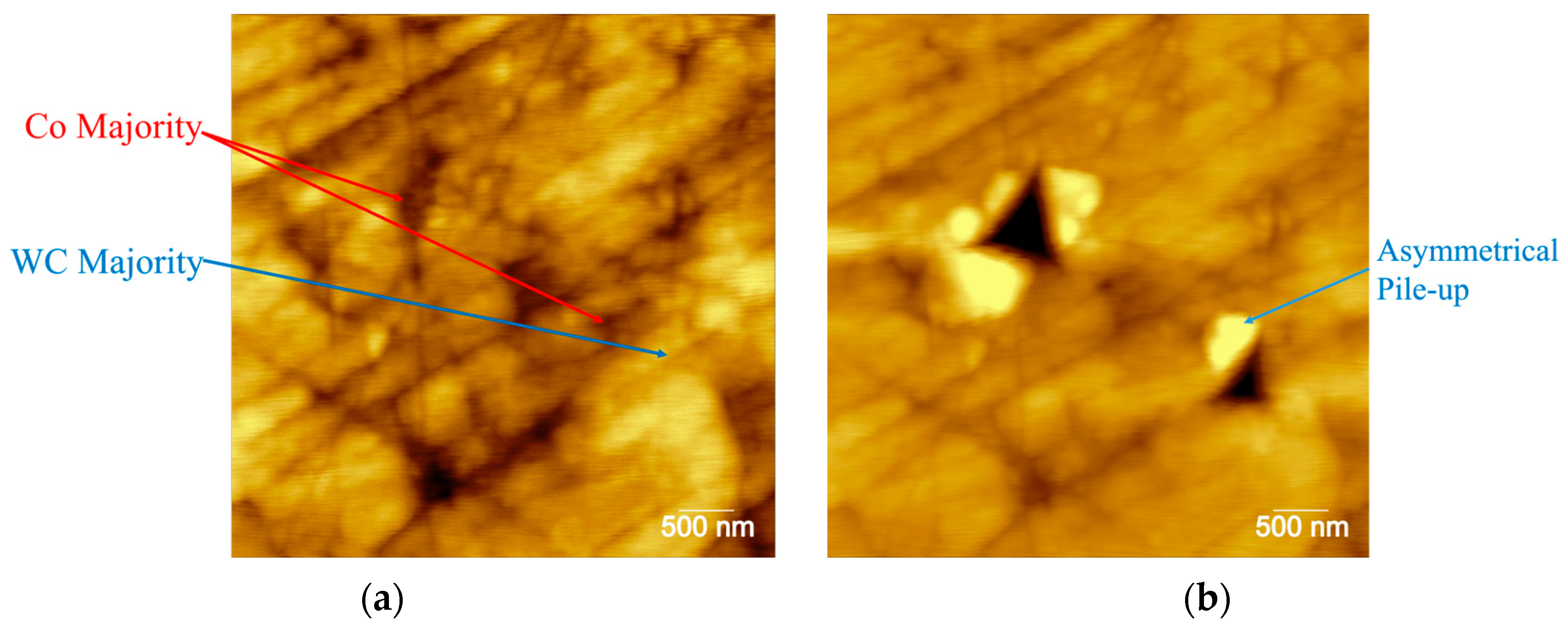
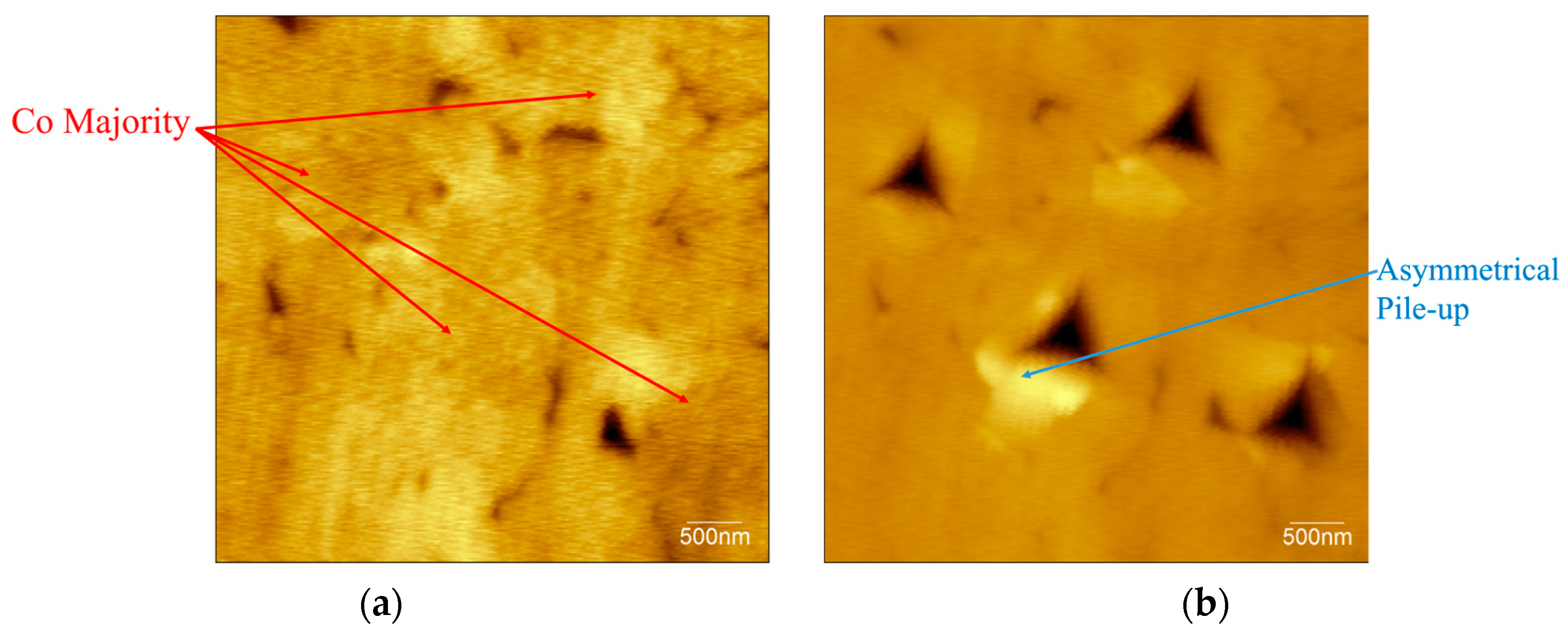
| Sample | Wt% W | Wt% C | Wt% Co |
|---|---|---|---|
| P | 77 ± 3.83 | 19 ± 3.30 | 5 ± 0.83 |
| B | 80 ± 1.21 | 12 ± 1.70 | 9 ± 0.62 |
| Indentation Depth and Hardness | P Sample | |||
|---|---|---|---|---|
| NCT | DCT | |||
| hmax (nm) | H (GPa) | hmax (nm) | H (GPa) | |
| Mean | 131.99 | 24.84 | 124.05 | 24.78 |
| SD | 23.86 | 4.25 | 5.35 | 2.15 |
| %SD | 18.08 | 17.12 | 4.32 | 8.69 |
| Indentation Depth and Hardness | B Sample | |||
|---|---|---|---|---|
| NCT | DCT | |||
| hmax (nm) | H (GPa) | hmax (nm) | H (GPa) | |
| Mean | 131.12 | 20.66 | 121.14 | 23.53 |
| SD | 8.64 | 2.64 | 6.27 | 2.41 |
| %SD | 6.59 | 12.79 | 5.17 | 10.23 |
| Indentation Depth and Hardness | hmax Before Treatment < 130 nm | hmax Before Treatment > 130 nm | ||||||
|---|---|---|---|---|---|---|---|---|
| NCT | DCT | NCT | DCT | |||||
| hmax (nm) | H (GPa) | hmax (nm) | H (GPa) | hmax (nm) | H (GPa) | hmax (nm) | H (GPa) | |
| Mean | 120.81 | 26.70 | 122.93 | 24.96 | 149.87 | 22.57 | 125.83 | 24.21 |
| SD | 6.00 | 2.79 | 5.61 | 2.29 | 27.47 | 4.26 | 4.58 | 1.80 |
| %SD | 4.96 | 10.47 | 4.56 | 9.18 | 18.33 | 18.89 | 3.64 | 7.42 |
| Sample | Sample | Vickers Hardness (HV1) | Cal. Hardness (GPa) | %SD |
|---|---|---|---|---|
| B | NCT | 1764 ± 43 | 17 ± 0.42 | 2.52 |
| DCT | 1842 ± 58 | 18 ± 0.57 | 3.14 |
Disclaimer/Publisher’s Note: The statements, opinions and data contained in all publications are solely those of the individual author(s) and contributor(s) and not of MDPI and/or the editor(s). MDPI and/or the editor(s) disclaim responsibility for any injury to people or property resulting from any ideas, methods, instructions or products referred to in the content. |
© 2025 by the authors. Licensee MDPI, Basel, Switzerland. This article is an open access article distributed under the terms and conditions of the Creative Commons Attribution (CC BY) license (https://creativecommons.org/licenses/by/4.0/).
Share and Cite
Premjarunan, S.; Tuchinda, K.; Worasaen, K. Study on the Effects of Cryogenic Treatment on WC-Co Cemented Carbide at Different Scales Using an Indentation Technique. Metals 2025, 15, 297. https://doi.org/10.3390/met15030297
Premjarunan S, Tuchinda K, Worasaen K. Study on the Effects of Cryogenic Treatment on WC-Co Cemented Carbide at Different Scales Using an Indentation Technique. Metals. 2025; 15(3):297. https://doi.org/10.3390/met15030297
Chicago/Turabian StylePremjarunan, Suparoj, Karuna Tuchinda, and Kaweewat Worasaen. 2025. "Study on the Effects of Cryogenic Treatment on WC-Co Cemented Carbide at Different Scales Using an Indentation Technique" Metals 15, no. 3: 297. https://doi.org/10.3390/met15030297
APA StylePremjarunan, S., Tuchinda, K., & Worasaen, K. (2025). Study on the Effects of Cryogenic Treatment on WC-Co Cemented Carbide at Different Scales Using an Indentation Technique. Metals, 15(3), 297. https://doi.org/10.3390/met15030297








